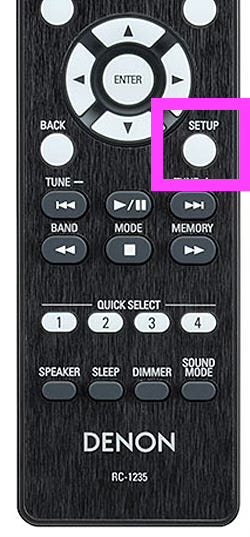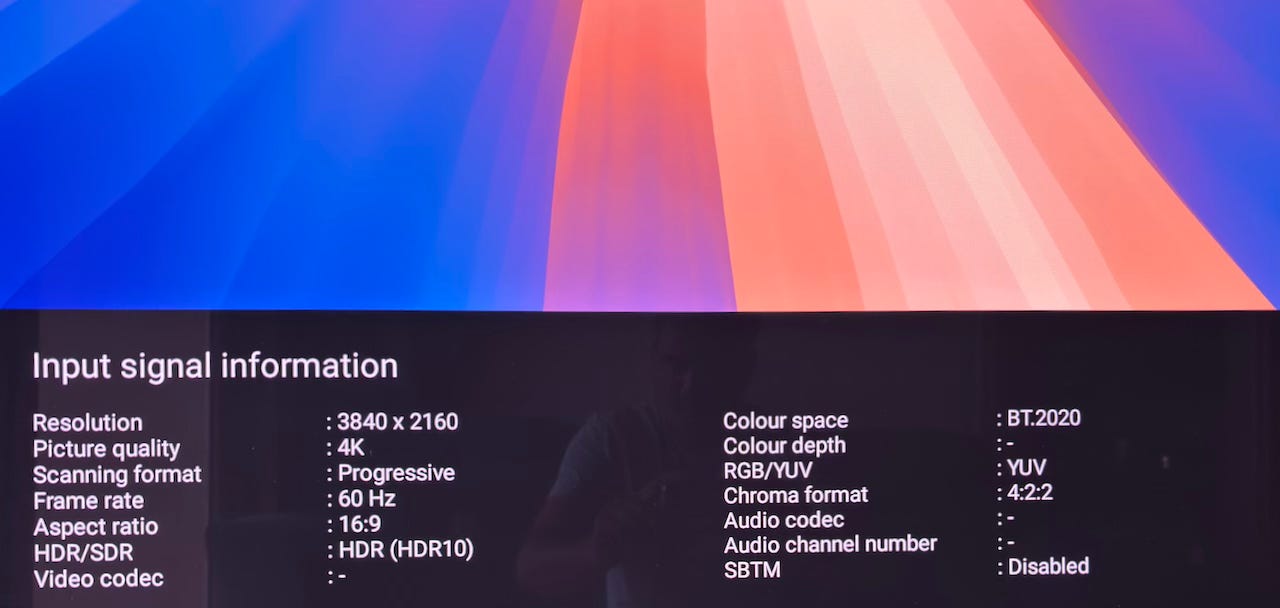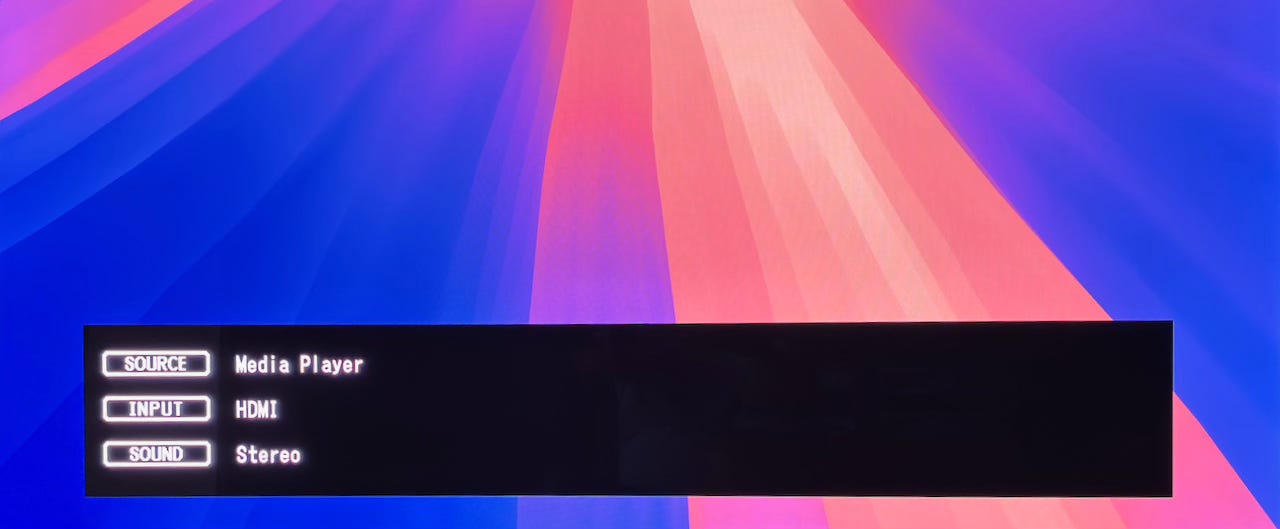How I Set up My Denon Receiver
… specifically the DRA-800H:
Physical setup
I used a surge protector. It has three output sockets, and I use only one, so that the surge protector is hopefully more effective.
The HDMI cable I had didn’t support all the features of the TV — UHD at 60 FPS with HDR and 4:2:2 chroma subsampling. So I bought this cable, which supports all the above plus 48 Gbps bandwidth, Ethernet, eARC and 8K at 60 FPS.
I connected my laptop to the HDMI input marked Media Player1. When I want to play from my laptop, I press the Media Player2 button on the receiver’s remote3, and then on the TV, select HDMI 34.
I connected the ARC port on the receiver to the ARC port on the TV.
I plugged in the receiver to Ethernet, since WiFi was causing interruptions in AirPlay5.
I placed the speakers (Q Acoustics 5040 floorstanders) with 50 cm space behind and to the side6.
Software setup
I configured my TV to send PCM output to my receiver7.
On the remote I pressed SETUP:
and changed the following settings:
Set Video > 4K Signal Format: Enhanced8.
Set Video > On Screen Disp. >
Video > TV Format: NTSC (otherwise the Denon UI runs at 50 FPS rather than 60)
I used a tape measure to measure the distances from the speakers to my ear11 in my normal seating position12 and entered it in Speakers > Distances.
On the remote, I pressed:
till I was in Pure Direct13.
After configuring everything, I plugged my laptop into the receiver, pressed the MEDIA PLAYER button on the receiver’s remote, and using the TV’s remote, switched it to the receiver. I played a HDR video full screen. On the TV, I selected Detailed signal info and verified that the TV is receiving UHD HDR at 60 FPS at 4:2:2:
In the HEOS app, I selected Quality High.
Features I don’t use
I don’t use Bluetooth, since it sounds worse14. I clicked Forget on all my devices so that I don’t accidentally connect.
AirPlay 2 doesn’t sound audibly worse, so it’s fine to use. When you’re done, terminate the connection by turning the receiver off, rather than from the Apple device (because that leaves the receiver on).
I don’t use analog input, since it sounds worse15.
Limitations of this receiver
The receiver’s USB port can’t accept digital input from a laptop. It can play only audio (not video) from a FAT32 mass storage device (not HFS+ or exFAT).
No VRR.
Only 60Hz.
Only ARC, not eARC.
No Google Cast16.
I can plug your laptop in to either the receiver or TV:
Laptop → Receiver <=> TV
or:
Laptop → TV <=> Receiver
and it will work, since the receiver and TV have a bidirectional connection via ARC.
The advantage of the former is that I can listen to music without turning on your TV, which would be bright and distracting.
The advantage of the latter is that I can use VRR, which my laptop and TV both support, but not my receiver.
I wish there were an input labeled Laptop or Computer, but there isn’t. The other inputs are Cable / Satellite, DVD, Blu-ray and Game, none of which don’t describe my laptop. It’s confusing to press the Cable / Satellite button to switch to my laptop. Media Player somewhat fits the bill, since I use my laptop as a media player when I connect it to my TV.
… to tell the receiver to switch to the laptop
… if the TV doesn’t automatically switch. This is the HDMI port into which the receiver is plugged in.
This also required buying a 5-port gigabit ethernet switch.
The amount of space behind is more important than to the side.
The closer you are to a wall, the more the music reflects off, which becomes boomy. What does that mean? It means low-frequency sounds linger. A drum should sound like “thump” but it ends up sounding like “thuuuuump”. It also makes me feel uncomfortable in my stomach.
Being close to the wall also makes it muddy. What does that mean? If you say “hello” to me, and it echoes off a wall and arrives at my ear with a delay, by the time I hear the “E” in “hello” from your mouth, the echoed “H” also arrives. So different syllables are mixed together, and are no longer clearly distinguishable, making it hard to hear what you’re saying.
So boominess and muddiness are the two problems that occur when you’re too close to a wall.
But being close to a wall also increases bass. Bass adds energy. Too far, like 3 feet space behind the speaker, and the music becomes anemic: I hear the notes but they don’t have an emotional impact. The boominess and muddiness are gone, so it’s theoretically perfect — it reproduces the original audio perfectly — but it sounds clinical. This defeats the point of listening to music.
So you need to balance these two conflicting forces. And that ideal balance is achieved when I have 0.5m space behind and to the side. The boominess and muddiness are reduced. The notes are clearer. It felt as if someone replaced my speaker with a slightly better one.
If you want to know in detail about my testing results and methodology, read on:
Rear distance test:
6 cm gap: Boomy and muddy compared to 20 cm
20 cm gap: Boomy and muddy compared to 1 foot
1 foot: Baseline
50 cm: Whatever little boominess and muddiness existed at 1 foot reduced. It seemed higher fidelity. Notes of music are clearer. It's as if someone replaced my speaker by a slightly better one.
2 feet: Marginally less boomy and muddy than at 50 cm
3 feet: Even less boomy and muddy, but the energy is less. The music is no longer emotional. It’s clinical: it reproduces the original audio perfectly, but it’s no longer emotional, so there’s no point in listening to music.
To validate these results, I then tried going back step by step from the longest distance of 3 feet:
2 feet: The music acquired a little more energy and strength.
50 cm: Marginally more boomy but also marginally stronger. It’s no worse.
1 foot: Boomy, I felt uncomfortable in my stomach. This is worse.
This shows that 50 cm is the ideal rear distance.
Methodology for the test: The side distance was kept constant at the 50 cm the manual recommends, in order to avoid varying two factors at once. The hall and kitchen windows and doors were closed and the curtains drawn. The speakers were placed symmetrically from me both horizontally and vertically. I played my favorite song Pagan Dream Machine (from my favorite genre of Psychedelic Electronic) which I’d listened to dozens of times and know intimately. I played a FLAC and used a HDMI, not wireless, connection from my Mac to the receiver. As I brought the speakers closer, I reduced the volume marginally to compensate for the increased loudness.
Side distance test:
Now that we’ve figured out what 50 cm rear space is ideal, keeping that constant, let’s try different side distances to see which one works best:
50 cm: Baseline
1 foot: Boomier than 50 cm.
20 cm: Marginally boomier than 1 foot.
6 cm: Marginally boomier than 20 cm. It’s apparent that it’s boomier when compared to 1 foot.
To validate these results, I again tried going in the reverse direction, from close to far: As I went from 6 cm → 20 cm → 1 foot, the boominess reduced, and when I went to 50 cm, it suddenly sounded like a higher-quality speaker.
Otherwise, the sound doesn’t play when using the Youtube app on the TV. Why? Because Youtube uses Opus, which the TV passes through to the receiver, but the receiver doesn’t support Opus, calling it an unknown format. So the sound doesn’t play at all. When I select Digital audio output to PCM, the TV decodes the Opus and sends the uncompressed audio to the receiver. Another reason to select PCM is that the receiver doesn’t support multichannel audio (not even downmixing it to stereo), so again you won’t hear any sound at all if the content you’re consuming uses multichannel audio.
Otherwise you don’t get 4K HDR 10-bit 60 FPS at 4:2:2 chroma subsampling.
Not the distance to the receiver.
You can’t measure the distance on the ground from the speaker to the beginning of the sofa, since that’s where your legs are, not where your ear is.
Which is better than Direct, which is better than Stereo. In Pure Direct, the sound was crystal clear and when there was a vocal, it seemed like that man was in my room, between the speaker and the receiver.
It sounds noticeably worse than HDMI, like a good rather than a great audio system.
I tried with three devices:
Macbook Pro (M1 Pro, 16-inch)
Audio-Technica ATR2x-USB adapter plugged into the same Mac
Sony A95L TV
All three have a 3.5mm jack, and I plugged in a 3.5mm - RCA cable.
Irrespective of the device, HDMI sounds better than analog. You want the digital-to-analog conversion happening in the receiver, not in the source device, even if the latter are high-end.
You can cast via the connected TV, which sounds worse than AirPlaying directly to the receiver. You get a video of the Chrome tab playing the FLAC file, rather than just the audio being cast as you’d want.






